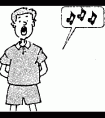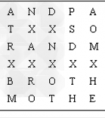Readandwrite. 按要求写词语。1. big (反义词) 2. short (反义词) 3. expensive (反义词) 4. 在公园里跑 (汉译英) 5. new (反义词) 6.Assistant:CanIhelpyou?Amy:Ye-四年级英语
2. 表示几点过几分,在分钟后加past,再加小时
five past seven 七点过五分
half past six 六点半
a quarter past eight 八点过一刻
seven past eight 八点过七分
3. 表示几点差几分,在分钟后面加to,再加小时
ten to eight 差十分八点(七点五十分)
a quarter to twelve 差一刻十二点(十一点四十五分)
twenty to six 差二十分六点(五点四十分)
在日常生活中,常用下列简单方法表示时间。
以小时、分种为单位分别读出数字。
6:31 读作 six thirty-one
10:26 读作 ten twenty-six
14:03 读作 fourteen o three
16:15 读作 sixteen fifteen
18:30 读作 eighteen thirty
23:55 读作 twenty-three fifty-five
注:时刻表上的时间大多采用24小时表示法,这样就不需要用a.m.表示上午,p.m.表示下午了。
三、年月表示法
1. 世纪可以用定冠词加序数词加世纪century表示,也可以用定冠词加百位进数加/’s表示
the sixth(6th)century 公元六世纪
the eighteenth(18th)century 公元十八世纪
the 1900/’s 二十世纪
the 1600/’s 十七世纪
这里,用百位数整数表示的世纪比这一百位阿拉伯数字本身多一个世纪。
2. 年代用定冠词及基数词表示的世纪加十位整数的复数形式构成
in the 1930/’s(in the thirties of the twentieth century或 in the nineteen thirties)
在二十世纪三十年代
in the 1860/’s(in the sixties of the 19th century或 in the eighteen sixties)
在十九世纪六十年代
In the 1870/’s when Marx was already in his fifties,he found it important to study the situation in Russia,so he began to learn Russian.
在十九世纪七十年代当马克思已经五十多岁时,他发现研究俄国的形势很重要,便开始学习俄语。
3. 表示某年代的早期、中期和晚期,可以在定冠词后,年代前添加 early,mid-,late
in the early 1920/’s 在二十世纪二十年代早期
in the mid-1950/’s 在二十世纪五十年代中期
4. 年月日表示法
A.年份用基数词表示,一般写为阿拉伯数字,读时可以以hundred为单位,也可以以世纪、年代为单位分别来读。
1949 读作 nineteen hundred and forty-nine 或 nineteen forty-nine
1800 读作 eighteen hundred
253 读作 two hundred and fifty-three或two fifty-three
1902 读作 nineteen hundred and two或 nineteen o two
表示在哪一年,一般在年数前加介词in,使用year时,year放在数词之前。
in the year two fifty-three B.C. 在公元前253年
但是,通常采用in加表示年份的阿拉伯数字。
B. 月份,在哪个月用介词in加第一个字母大写的月份词表示。
例如:in May在五月; in July在七月。
为了简便起见,月份与日期连用时,月份常用缩写形式表示。
缩写形式除May,June,July外,其它的月份都由其前三个字母表示,但September除外。
January——Jan.一月
February——Feb.二月
March——Mar. 三月
April——Apr.四月
August——Aug.八月
September——Sept.九月
October——Oct.十月
November——Nov.十一月
December——Dec.十二月
注:这里缩写形式后面加点不能省略,因为它是表示缩写形式的符号。
C.日期用定冠词the加序数词表示。在哪一天要添加介词on。
National Day is on Oct. 1.
国庆节是十月一日。(读作 October first)
此句也可以表示为 National Day is on the 1st of October.
May 5 五月五日(读作May fifth)
也可以表示为the fifth(5th)of May
Mar. 1(st) 三月一日(读作March first或 the first of March)
5. 表示不具体、不确切的时间,如世纪、年代、年份、月份时,用介词in表示;
表示具体确切的某一天用介词on表示通常情况下morning,afternoon,evening等词前用介词in。
但是,当这些词前后有一修饰限定的词作为定语,把它们限定为某一天早晨、下午或晚上时,介词in应改为on。
这里的修饰限定词可以是介词短语、名词、形容词、定语从句等。
On a cold morning,the old man died lonely in his house.
在一个寒冷的早晨,这个老人孤独地死在自己的房子里。
I don/’t want to be disturbed on nights when I have to study.
我不愿意在我必须学习的晚上被打扰。
The accident happened on the afternoon of July 7.
这次事故发生在7月7日下午。
We are to have a small test on Monday morning.
星期一早晨我们将进行一次小测验。
四、加减乘除表示法
1. “加”用plus,and或add表示;“等于”用is,make,equal等词表示。
2+3=? 可表示为: How much is two plus three?
2+3=5
Two plus three is five.
Two and three is equal to five.
Two and three make five.
Two added to three equals five.
If we add two to/and three, we get five.
二加三等于五
2. “减”用 minus或 take from表示
10-6=? How much is ten minus six?
10-6=4
Ten minus six is four.
Take six from ten and the remainder is four.
Six (taken) from ten is four.
十减去六等于四
3. “乘”用time(动词)或multiply表示
3×4=? How much is three times four?
3×4=12
Three times four is/are twelve.
Multiply three by four,we get twelve.
Three multiplied by four makes twelve.
三乘以四等于十二
4. “除”用divide的过去分词形式表示
16÷4=? How much is sixteen divided by four?
16÷4=4
Sixteen divided by four is four.
Sixteen divided by four equals/gives/makes four.
十六除以四等于四。
考点名称:不定冠词(a,an)
不定冠词的基本用法:
(1)不定冠词有a和an两种:a用于辅音音素开头的词前,an用于元音音素开头的词前。
例如:a boy, a city, a girl, a useful animal , an old man, an honest boy, a bad apple, a tall elephant
(2) 用来表示“一”的意思,但不强调数的观念,只说明名词为不特定者。即不具体说明是何人何物。
例如:A teacher is looking for you. We work five days a week.
(3)不定冠词含有“一”的意思,但数量观念没有one强烈,在句子里边一般可以不必译出,但若有“一个”的意思则译出,
例如:An orange is good for you. 桔子对你有好处。
(4)一般用在可数名词单数前,指人或事物的某一种类。
例如:Bill is a student. This is a ruler.
(5)用在某些固定词组中。
例如:a lot of, a moment ago, a few, a little- 不定冠词的指代:
1. 首次提到的人或物。
2.指人或事物,但不具体说明何人或何物。
There are seven days in a week.We have three meals a day.
3.表示“一个”,但数的概念没有one强。
There’s a tree on the hill.He has an interesting book.
4.指某类人或事物中的任何一个。
An elephant is bigger than a horse.A car runs faster than a bike. an与a的区别:
1)a用在以辅音字母开头,或以读做辅音的元音字母开头的单词前面:
例如:a man一个男人 a university一所大学 a hat一顶帽子 a European一个欧洲人
2)an用在以元音字母(a,e,i,o,u)开头,或以不发音的h字母开头的单词前面:
例如:an apple一个苹果 an island一个岛 an uncle一位大叔 an onion一个洋葱 an egg一个鸡蛋 an hour一小时
3)an还用在发音以元音开头的单个字母前面:
例如:an L-plate一块“实习驾驶”车牌 an MP一个国会议员 an SOS一个呼救信号 an‘x’一个x字母、X形的东西或未知数
4)a/an没有性的变化:
例如: a man一个男人 a woman一个女人 an actor一个男演员 an actress一个女演员不定冠词与数词one区别:
不定冠词与数词one都可表示“一”的意思,前者可视为后者的弱式。
- 最新内容
- 相关内容
- 网友推荐
- 图文推荐
| [家长教育] 孩子为什么会和父母感情疏离? (2019-07-14) |
| [教师分享] 给远方姐姐的一封信 (2018-11-07) |
| [教师分享] 伸缩门 (2018-11-07) |
| [教师分享] 回家乡 (2018-11-07) |
| [教师分享] 是风味也是人间 (2018-11-07) |
| [教师分享] 一句格言的启示 (2018-11-07) |
| [教师分享] 无规矩不成方圆 (2018-11-07) |
| [教师分享] 第十届全国教育名家论坛有感(二) (2018-11-07) |
| [教师分享] 贪玩的小狗 (2018-11-07) |
| [教师分享] 未命名文章 (2018-11-07) |

![读句子,选出正确的图。Whatabigwatermelon![ ]A.B.-四年级英语](http://www.00-edu.com/d/file/ks/4/1/7/2019-08-11/small4a305321f43da5b832321508021a7edb1565477037.gif)


![根据图片,选择正确答案。1. Tom sends nine postcards to his _____________ .[ ]A. brotherB. motherC. father2. Where do I put the _____________ ?[ ]A. stamp-五年级英语](http://www.00-edu.com/d/file/ks/4/1/7/2019-08-11/smallb78172089d6038aa813d3891109792701565492155.gif)

